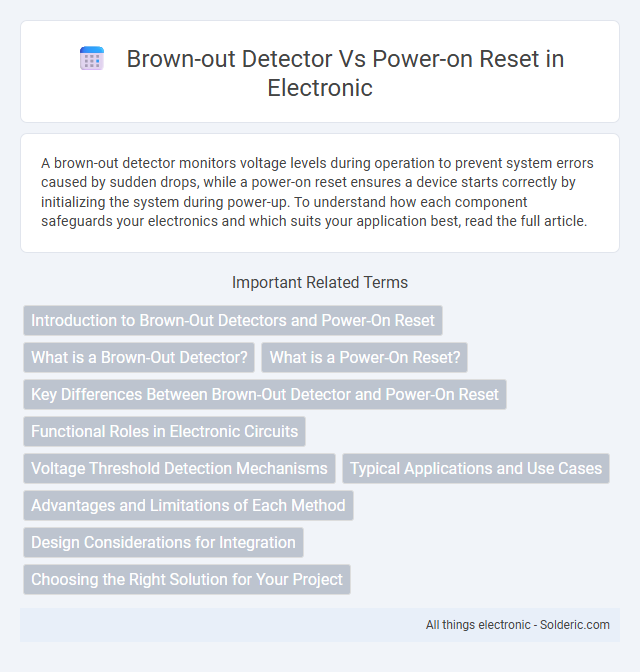A brown-out detector monitors voltage levels during operation to prevent system errors caused by sudden drops, while a power-on reset ensures a device starts correctly by initializing the system during power-up. To understand how each component safeguards your electronics and which suits your application best, read the full article.
Comparison Table
| Feature | Brown-out Detector (BOD) | Power-on Reset (POR) |
|---|---|---|
| Function | Monitors supply voltage dips during operation | Resets system on initial power application |
| Activation | Triggered when voltage falls below a predefined threshold | Triggered once during power-up when voltage crosses reset threshold |
| Purpose | Prevents malfunction due to low voltage conditions during runtime | Ensures system starts correctly on power application |
| Operation Time | Continuous monitoring during device operation | Occurs once at power-up |
| Typical Use Case | Embedded systems requiring voltage supervision | Microcontrollers and processors initialization |
| Reset Behavior | Triggers reset or interrupt on brown-out event | Generates reset pulse during power-up |
| Voltage Threshold | Configurable thresholds below nominal voltage | Fixed threshold tied to power supply turn-on level |
Introduction to Brown-Out Detectors and Power-On Reset
Brown-out detectors and power-on reset circuits play crucial roles in embedded systems to ensure reliable operation during power fluctuations. A brown-out detector monitors the supply voltage and triggers a system reset when the voltage drops below a predefined threshold, preventing erratic behavior in microcontrollers. Power-on reset circuits initialize your system by holding it in a reset state until the supply voltage stabilizes during startup, guaranteeing a clean and stable boot process.
What is a Brown-Out Detector?
A Brown-Out Detector (BOD) is an integrated circuit feature that monitors the supply voltage level to prevent system malfunctions during undervoltage conditions. It triggers a reset or interrupt when the voltage drops below a predefined threshold, ensuring the microcontroller or processor operates reliably without erratic behavior. Unlike a Power-On Reset (POR), which activates only during initial power application, a BOD continuously supervises voltage levels during operation to maintain system stability.
What is a Power-On Reset?
A Power-On Reset (POR) is a crucial hardware feature that ensures a microcontroller or digital system starts in a known state by generating a reset signal during initial power-up. This reset prevents unpredictable behavior by holding the system in reset until the supply voltage reaches a stable operating level. Your device relies on POR to guarantee reliable startup and proper initialization upon powering on.
Key Differences Between Brown-Out Detector and Power-On Reset
Brown-out detectors monitor voltage levels during device operation, triggering a reset if the supply voltage dips below a threshold to prevent erratic behavior. Power-on reset circuits activate only during initial power-up, ensuring the system starts in a known state by holding it in reset until voltage stabilizes. Your choice depends on whether continuous voltage monitoring (brown-out detector) or startup initialization (power-on reset) is more critical for your application's reliability.
Functional Roles in Electronic Circuits
Brown-out detectors monitor voltage levels and trigger a reset when supply voltage dips below a predefined threshold, preventing erratic behavior during brief undervoltage conditions. Power-on reset circuits ensure the microcontroller starts in a known state by generating a reset signal during power-up or after complete power loss. Your electronic system relies on these components to maintain stability and reliable operation under varying power conditions.
Voltage Threshold Detection Mechanisms
Brown-out detectors monitor supply voltage levels continuously, triggering a reset when the voltage drops below a predetermined threshold to prevent erratic system behavior. Power-on reset circuits activate only during initial power-up, ensuring the system starts with a stable voltage above a specified threshold before operation begins. Both mechanisms rely on voltage threshold detection, but brown-out detectors provide ongoing protection against undervoltage conditions, while power-on resets focus solely on system initialization.
Typical Applications and Use Cases
Brown-out detectors are essential in battery-powered devices and embedded systems to prevent erratic operation during voltage dips by monitoring supply voltage and triggering system resets or safe modes. Power-on reset circuits are commonly used in microcontrollers and digital systems to ensure reliable startup by initializing hardware and software when the device is powered on. Your system benefits from integrating brown-out detection when stable operation during fluctuating power is critical, while power-on reset ensures proper initialization at startup.
Advantages and Limitations of Each Method
Brown-out detectors provide continuous monitoring of the supply voltage, enabling your system to reset whenever voltage dips below a safe threshold, which protects against erratic behavior caused by transient power drops. Their advantage lies in maintaining system stability without requiring a complete power cycle, but they may introduce false resets during brief voltage fluctuations. Power-on reset circuits guarantee a clean startup by holding the system in reset until the voltage reaches a defined level, ensuring reliable initialization, though they lack ongoing voltage supervision and may fail to protect against mid-operation voltage drops.
Design Considerations for Integration
Design considerations for integrating a brown-out detector versus a power-on reset revolve around ensuring system reliability under varying power conditions; brown-out detectors continuously monitor voltage levels to prevent erratic behavior during dips, while power-on resets initialize the system only at startup. You must evaluate the microcontroller's voltage tolerance, response time, and the criticality of uninterrupted operation to select the appropriate protection mechanism. Proper integration balances hardware complexity and power consumption while safeguarding data integrity during voltage fluctuations.
Choosing the Right Solution for Your Project
Choosing between a brown-out detector and a power-on reset hinges on your project's power stability needs and response timing. Brown-out detectors continuously monitor supply voltage, triggering resets during voltage dips to prevent erratic behavior, making them ideal for battery-powered or unstable environments. Power-on reset circuits ensure stable startup by generating a reset signal only during initial power application, suitable for systems with consistent power sources where startup integrity is critical.
Brown-out detector vs Power-on reset Infographic

 solderic.com
solderic.com